Off-Grid – How many solar panels do I need?
Overview:
Selecting the right PV system size for your off-grid system is a critical step for a reliable system to power your loads when you need them. There are multiple ways to determine/predict the production of a future installation. In the following steps we’ll discuss a few easy-to-use methods that do not require any third-party, fee-based software tools. We will be using data from the Natural Resources Canada databases, free of charge.

There are 4 main factors that determine directly or indirectly, the energy production of a solar installation:
- a.) Location
- b.) Orientation
- c.) Inclination/Angle
- d.) Possible shading conditions
Often the ideal location or orientation cannot be achieved, so a compromise is necessary. Compared to other system components of an off-grid system, solar panels are very affordable and by slightly increasing the system size, limitations due to partial shading or not ideal orientation can be compensated for.
We highly recommend reading through this tech-tip to understand how this tool’s calculations are being performed, it will also give some explanation as to what the tool expects to see with regards to input. While the tool can be used live on our site, it can be edited by anyone, therefore overwrite your information could be overwritten. We highly recommend either making a copy, which you can do so by clicking here or download it by clicking here. The tool is located here.
Follow along with our 7-step off-grid solar sizing guide:
Step 1:
Collect data about your application and location:
- a.) What is the location of the system? (Latitude) e.g. Four Mile Lake, ON, Latitude 44°
- b.) What is the closest (large) municipality? e.g. Kawartha Lakes, ON
- c.) What is the inclination of an available roof? e.g. 6/12 pitch or 26deg
- d.) What is the expected daily load in the summer? e.g. 2500Wh or 2.5kWh per day
- e.) What is the expected daily load in the winter? e.g. 3400Wh or 3.4kWh per day
Step 2:
Go to the Government of Canada website via the following link:
https://open.canada.ca/data/en/dataset/8b434ac7-aedb-4698-90df-ba77424a551f
Scroll down and select ‘Municipality database – Photovoltaic potential (kWh/kWp)’ CSV dataset:
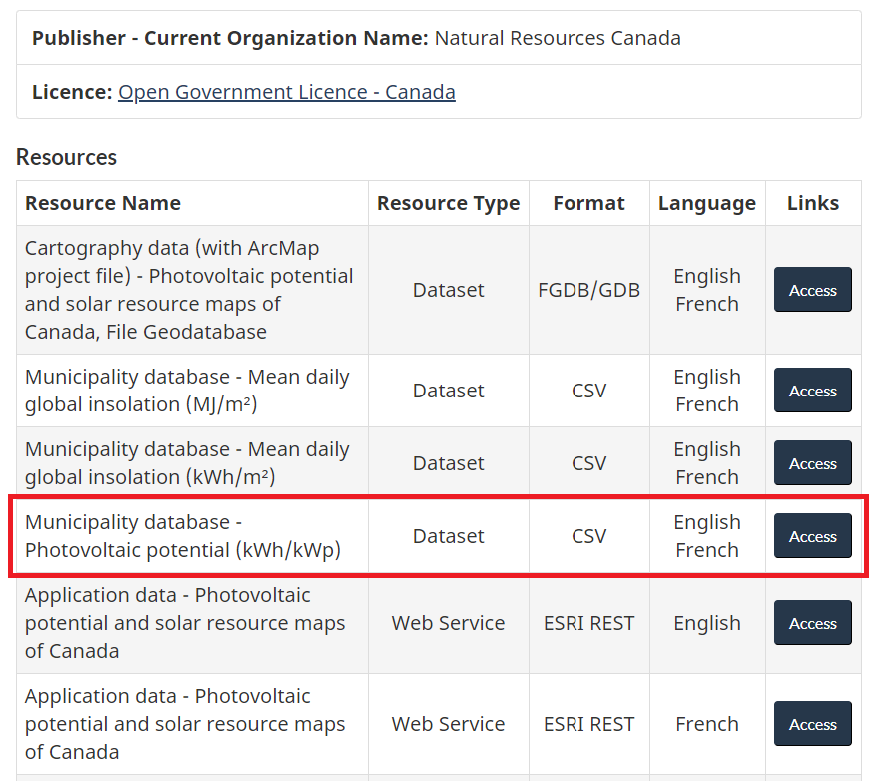
The database .csv file can be opened with Microsoft Excel, Google Sheets, or any LibreOffice Calc program.
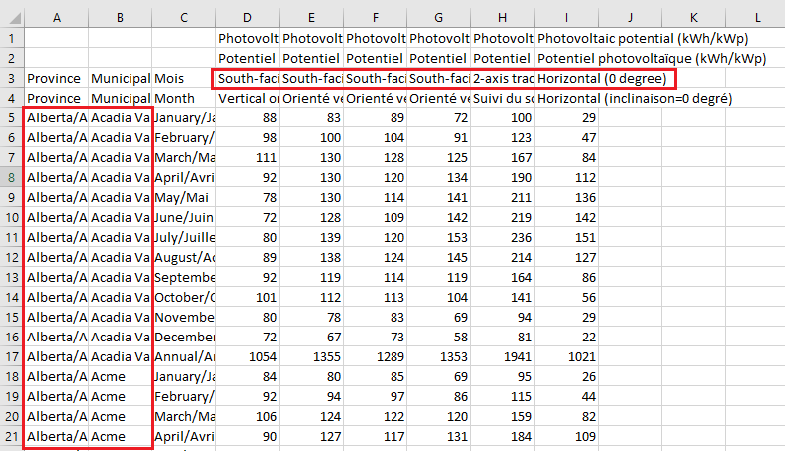
Column A and column B list all municipalities in Canada
Row 3 lists different tilt angles with a directly south-facing orientation
The six available options are:
Column D: South-facing with vertical tilt (90 degrees)
Column E: South-facing with latitude tilt (in our example 44°)
Column F: South-facing with tilt=latitude+15 degrees (in our example 59°)
Column G: South-facing with tilt=latitude-15 degrees (in our example 29°)
Column H: 2-axis tracking (not applicable to our example)
Column I: Horizontal (0 degree)
Step 3:
Search for your municipality by pressing ‘CTRL+F’
(e.g. Kawartha Lakes)
Select the appropriate column for the type of installation
(e.g. Column G for latitude-15deg for our ~26deg tilt 6/12 pitch)
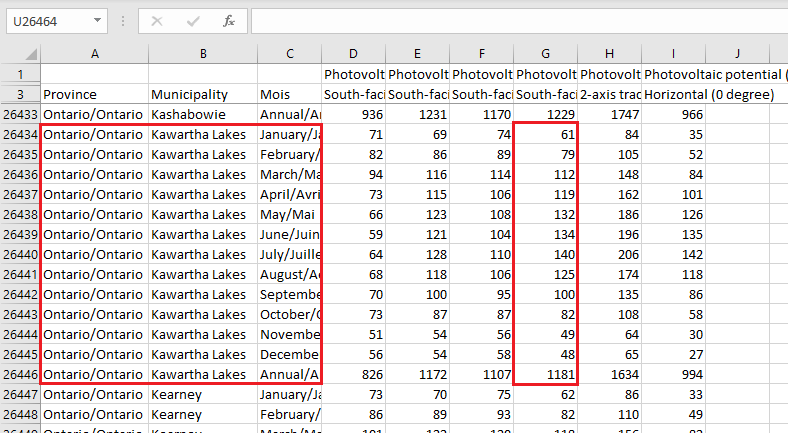
Step 4:
Data analysis to determine the proper solar PV array size for the two Summer and Winter load conditions.
Summer analysis:
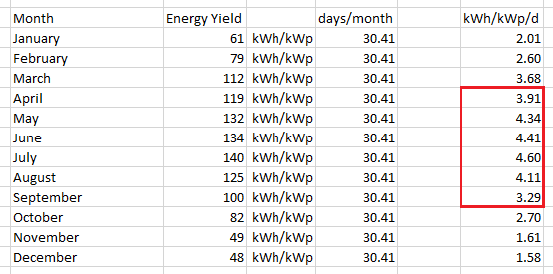
In the summer months, from April to September, the specific energy yield of the system would range between a low of 3.29 kWh/kWp in September to a high of 4.60 kWh/kWp in July. The average yield in those months can be calculated to approximately 4.11 kWh/kWp.
Winter analysis:
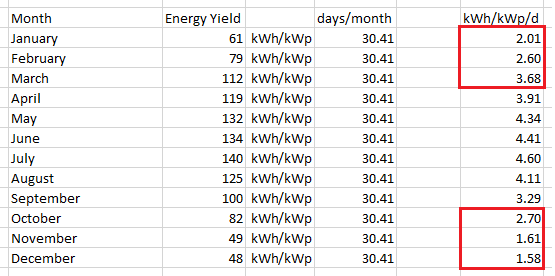
In the winter months from October to March, the specific energy yield of the system would range between a low of 1.58 kWh/kWp in December to a high of 3.68 kWh/kWp in March. The average yield in those months would be approximately 2.3 kWh/kWp.
Step 5:
Calculating the size of the solar PV system based on the expected load.

With Eload being the daily summer energy consumption in kilowatt-hours, Espec being the specific yield of a solar system. Specific yield describes how many kilowatt-hours of energy a system of a specific size (in this case per 1000Wdc = 1kWp) will produce in each time period (in this case 1 day).
Summer:
In our example the daily summer energy consumption(Eload) was given at ~2500 Wh or 2.5 kWh.

With Espec being selected as the lowest daily yield in the selected summer period (in this case September). The power of the solar system would need to be 0.76 kWp or 760WDC.
Winter:
The winter the daily energy consumption (Eload) was given at ~3400 Wh or 3.4 kWh.

With Espec being selected as the lowest daily yield in the selected summer period (in this case December). The power of the solar system would need to be 2.15 kWp or 2150 WDC. As expected, with the generally higher consumption in the darker season of the year, combined with lower solar IR radiance and shorter days, the solar system capacity needs to be significantly increased to cover this lower producing season.
Step 6:
Each system has inefficiencies and losses. These losses are related to power conversions in inverters or charge controllers but also in the type of battery storage you choose to install.
In addition to the losses the above calculations are considering daily averages. The solar system needs to be designed larger than just the size to cover the daily average consumption. In case there will be a rainy day on the next day, the solar system must provide energy to recharge the batteries from the day before as well as to provide power for the current day.
Every system is different and will have a different overall efficiency. A general rule of thumb is to account for about 20-25% system losses. For the recharging capabilities after a lower-than-average yield day a safety factor of roughly 30% is added to the system size.
This will lead to the following equation in the summer:
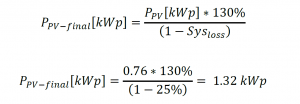
In a winter application with a higher daily consumption, the solar system size, and linearly the cost of the system, will increase significantly. A balance between all energy covered with solar (large, oversized solar array) and the runtime of a backup generator must be found.
Step 7:
Conclusion for mainly Summer Usage:
If the system is mainly used over the peak summer months, a 1 kWDC system could be selected. This size would provide sufficient power in 95% of all summer month weather conditions. In the shoulder seasons, spring and fall, additional solar power would be helpful for a more robust operation of the system. e.g. 2kWDC
Conclusion for mainly Winter Usage:
If this system would be used daily year-round, we would go back to step 2 of this manual and would see that specific yield over the winter month of a system at higher tilt angle (column F, 59deg) would be better suited. At the same time the higher tilt angle would not affecting the production in the summer month too much (higher yield due to larger array in addition to lower summer loads). In such a scenario a ~3kWDC solar system with an addition of a smaller backup generator would be the most suitable option.
Solar Sizing Rule of Thumb:
Summer:
for every watt-hour [Wh] of load, you need 0.5WDC solar power
e.g. 2000Wh load => 1000WDC or 1kWDC solar power
Winter:
for every watt-hour [Wh] of load, you need 1WDC solar power
e.g. 2000Wh load => 2000WDC or 2kWDC solar power
Disclaimer:
In off-grid design, every application and system are different. This guide is intended to educate off-grid users about their future system’s production and help understand it’s limitations.






















































